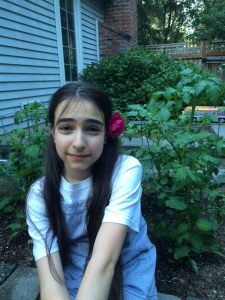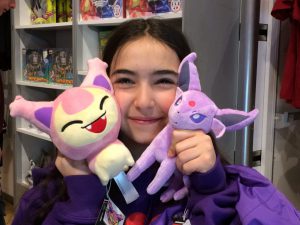
Since Eva Tomassini was 4 years old, she remembers her life being controlled by rules. Not from her parents, or school, but rules she created in her head, like having to arrange things in a certain way or run away in order to prevent terrible things from happening. As Eva grew older, her compulsions and obsessions got worse. She thought if she didn’t follow the rules, someone close to her would be harmed or die.
Eva has Obsessive-Compulsive Disorder (OCD), a disorder that literally ruled her life throughout her childhood.
“It was like she was controlled by an evil puppet master,” said Earlyn Tomassini, Eva’s mother. “She had spontaneous rules she had to follow or she’d run away at night because her OCD would tell her something bad would happen to somebody if she didn’t. It was really difficult for her and for our family.”
OCD is a common, chronic disorder that affects nearly 3% of the population. A person with OCD has uncontrollable, recurring thoughts (obsessions) and/or behaviors (compulsions) that he or she feels the urge to do or repeat over and over, according to the National Institute of Mental health. Obsessions are repeated thoughts or urges caused by anxiety. Compulsions are repetitive behaviors a person with OCD feels they need to sometimes do in response to an obsessive thought. For Eva, her obsession was the thought that someone may be harmed. Her compulsion was to run away or create arbitrary rules.
“A common OCD thought for a child is thinking ‘something bad is going to happen to my parents,’” said Dr. Geoffrey Wiegand, director of the Intensive Outpatient OCD Treatment Program at Seattle Children’s. “Typically, people with OCD don’t act on their thoughts, but it’s alarming to them and their thoughts can be very disturbing.”
Finding help
“We knew we wanted to find a program that could help Eva, but we were having trouble finding a place to go,” said Tomassini. “There weren’t a lot of options.”
Previously, Eva had gone through six months of once a week therapy to try to treat her OCD symptoms, but nothing seemed to work.
“She felt so alone,” said Tomassini. “Nothing was working and she was getting worse.”
In June, Eva’s compulsions became overwhelming. Unfortunately, at the same time, Eva’s grandmother fell ill and passed away, which in her mind confirmed her fear that if she didn’t run away, someone would get hurt.
“She thought it was because of her OCD,” said Tomassini.
Eva was admitted to Seattle Children’s for a week, which is where she and her family learned about the Intensive Outpatient OCD Treatment Program. After she was released, she completed an intake screening for the program.
When she was first accepted to the program, Eva wasn’t optimistic.
“She thought she was defective,” said Tomassini. “She didn’t think it would work.”
Conquering fears
“Kids who are accepted into the program are here because they’ve failed other treatments, or because they’ve been hospitalized,” said Wiegand. “The program typically lasts four to eight weeks. We help the kids conquer their fears using cognitive behavior therapy, also known as ‘exposure.’ We teach both kids and their parents how to gradually expose kids to their fears.”
 Exposure treatments have been shown to be very effective in treating patients with OCD. Wiegand and his team use exposure to help patients with OCD overcome their anxiety.
Exposure treatments have been shown to be very effective in treating patients with OCD. Wiegand and his team use exposure to help patients with OCD overcome their anxiety.
“When you expose people to the things that frighten them over and over again, you’ll eventually get to a point where it doesn’t frighten them anymore,” said Wiegand. “Take for instance someone who is afraid of spiders. Over time we expose them to what they fear, first starting out with pictures of spiders and then slowly helping them get closer and closer to a spider.”
After only a few weeks in the program, Eva and her family were seeing tremendous results.
“She was finally able to realize that her OCD was a bully,” said Tomassini. “It had been controlling her and pushing her around. Today, that’s not happening anymore.”
Week after week, they continued to see progress. They would practice exposures at home with Eva and over time she learned to keep the OCD at bay.
“Her progress was incredible,” said Tomassini. “At first, you think the exposures are so bizarre, but they really work. Take a kid who might have an obsession with germs. You would never ask them to put their hand in the toilet, but that’s what you have to do. You have to push them to the extreme. It’s like recalibrating them.”
Increasing access for kids
Seattle Children’s Intensive Outpatient OCD Treatment Program is only one of a handful of intensive programs in the country. Since the program opened in July, Wiegand has seen tremendous success.
“The kids are graduating earlier than we expected,” said Wiegand. “They’ve done such a good job crushing their anxiety. The kids have demonstrated real courage. They made a list of everything they’re afraid of and conquered it. OCD in the beginning was a weakness, but now they have the confidence to push through their anxiety and get to the other side. They graduate having more courage than the average person ”
After about five weeks in program, Eva graduated.
 “When I graduated, I finally felt free again,” said 14-year-old Eva, “I felt that nothing was too hard, or too scary or too anything for me to do it. The idea that I could do anything I was passionate about was almost too good to be true. I am confident that graduation day will always be one of the best days of my life.”
“When I graduated, I finally felt free again,” said 14-year-old Eva, “I felt that nothing was too hard, or too scary or too anything for me to do it. The idea that I could do anything I was passionate about was almost too good to be true. I am confident that graduation day will always be one of the best days of my life.”
Although OCD is a chronic, life-long condition, the program helps teach children and families how to spot OCD and know what to do when symptoms appear.
“The golden rule is to do the opposite of what your OCD tells you,” said Wiegand. “If it wants you to take a step away from the spider, you take a step toward the spider. We’re asking kids to be courageous, and I’m really proud of these kids for it.”
“There are a lot of misconceptions out there about OCD,” said Tomassini. “We want people to know they’re not alone and that there is hope. We’re so happy we found Seattle Children’s.”
If your child needs treatment for OCD please contact your primary care physician or Seattle Children’s Psychiatry and Behavioral Medicine Team at 206-987-2164.
Resources:
- Seattle Children’s Tackles Tourette’s, OCD with Innovative Therapies

